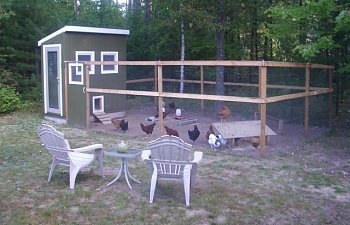OLSON COOP DESIGN
After considerable discussion, my daughter, Natalie, and my wife, Marina, convinced me we should raise chickens. Natalie wanted them for pets and Marina wanted them for eggs. We decided to raise laying hens with no roosters. I went down to the Hometown Feedmill in Tomahawk, Wisconsin, where we live and Carl Felser and Charlie were a great help. I came home with a brochure from Mt Healthy Hatcheries Inc, Mt Healthy, Ohio. Initially we were only going to raise 6 to 8 chickens, but due to the 15 chick order requirement, that is the number we decided on. The girls selected the breeds they wanted (2 Auracanas, 2 Light Brahmas, 2 Jersey Black Giants, 2 Golden Comets, 2 New Hampshire Reds, and 5 Rhode Island Reds). The chicks arrived on June 10th, 2009 and we kept them in the brooder I built in the garage. Our garage became a flurry of activity with all the visitors.

Meanwhile I commenced building the coop and run. I decided on a 4' wide x 8' long x 7' high coop to minimize heating costs due to the long winters in Northern Wisconsin. I built the foundation with concrete block. Used 2 x 4s for the floor joists, insulated the floor with 2" closed cell foam insulation and 3/4" plywood for the flooring. I framed the walls with 2 x 4s on 24" centers. I installed three 24" square, double pane, low-e windows which I built into the wall leaving out the top header to allow the window to be raised and lowered during the summer months. I covered the exterior of the windows with 1/4" gap wire mesh and framed with pine. The door is a wood frame, double pane, low-e glass for extra sunlight. The roof I built with 2 x 4 rafters, 5/8" plywood sheeting and three tab shingles.

I covered the exterior walls with 3/8" LP SmartPanel. I covered the interior walls and ceiling with 3/8" LP Smartside soffit and insulated with closed cell foam insulation. The door to the run I built with 3/8" LP SmartPanel with 2" foam insulation sandwiched in between to prevent heat loss.

I built several roosts from birch, red oak, and aspen branches which I continually had to raise to their present locations as the chickens grew. The nests I built from 3/8" LP SmartPanel stacked on the Northeast wall. I had planned on building exterior doors to the nests for egg gathering but ended up deciding against it, something I may regret.


I wired the coop running 14/2 exterior wire from the house and wired in a ceiling light with interior coop switch and a switch in our basement (to add light for egg production during the short winter months) and a wall outlet for plugging in heater waterers, etc. Since I had the coop wired I decided to add a AM/FM CD player to let the chickens listen to the local radio station WJJQ.

The run is 16' x 28'. I used landscape timbers for posts and chicken wire with 2 x 4s placed six feet high along the top of the posts and 1 x 4s placed at 36" high to secure the chicken wire. I left the top open because of the many comments I read regarding snow/freezing rain collapsing or sagging the wire. There is a red oak tree in the run to minimize the risk from eagles and hawks which would also create a problem for me to cover the run. So far we haven't had a problem. Before the snow flies I will be adding several more roosts in the run to allow the pullets to be out of the snow and I will raise the mini-coop in the run above snow level and keep it filled with fresh shavings.

The coop and run have became a place where my wife and I sit in the evenings and watch the chickens. It is quite entertaining. My daughter has named all the chickens and many of her friends enjoy coming over and sitting with the chickens. Most of them will come up and sit in her lap and one of the Auracanas enjoys sitting on her shoulder.



Currently all of the water and feed are kept in the run as we leave the door to the run open 24/7. We will end up bringing one of the waterers and feeders inside the coop during the winter months as we intend on closing up the coop on the coldest nights. We are still feeding the PenPals medicated starter feed since the pullets are still only 14 weeks old. At 18 weeks we are going to switch them to a laying feed mix designed by the Hometown Feedmill which we will supplement with oyster shells.
After considerable discussion, my daughter, Natalie, and my wife, Marina, convinced me we should raise chickens. Natalie wanted them for pets and Marina wanted them for eggs. We decided to raise laying hens with no roosters. I went down to the Hometown Feedmill in Tomahawk, Wisconsin, where we live and Carl Felser and Charlie were a great help. I came home with a brochure from Mt Healthy Hatcheries Inc, Mt Healthy, Ohio. Initially we were only going to raise 6 to 8 chickens, but due to the 15 chick order requirement, that is the number we decided on. The girls selected the breeds they wanted (2 Auracanas, 2 Light Brahmas, 2 Jersey Black Giants, 2 Golden Comets, 2 New Hampshire Reds, and 5 Rhode Island Reds). The chicks arrived on June 10th, 2009 and we kept them in the brooder I built in the garage. Our garage became a flurry of activity with all the visitors.
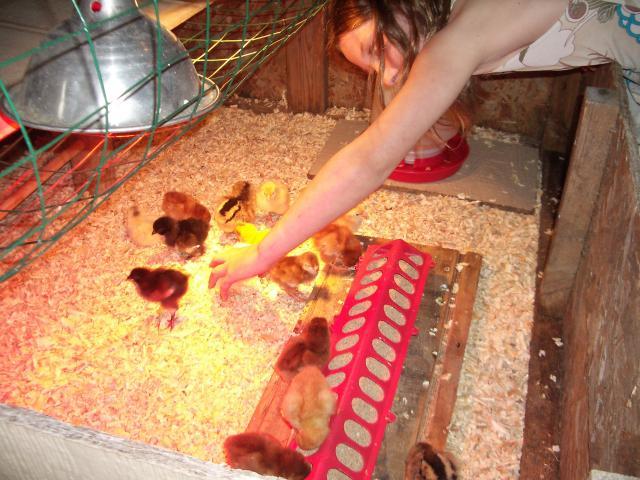
Meanwhile I commenced building the coop and run. I decided on a 4' wide x 8' long x 7' high coop to minimize heating costs due to the long winters in Northern Wisconsin. I built the foundation with concrete block. Used 2 x 4s for the floor joists, insulated the floor with 2" closed cell foam insulation and 3/4" plywood for the flooring. I framed the walls with 2 x 4s on 24" centers. I installed three 24" square, double pane, low-e windows which I built into the wall leaving out the top header to allow the window to be raised and lowered during the summer months. I covered the exterior of the windows with 1/4" gap wire mesh and framed with pine. The door is a wood frame, double pane, low-e glass for extra sunlight. The roof I built with 2 x 4 rafters, 5/8" plywood sheeting and three tab shingles.
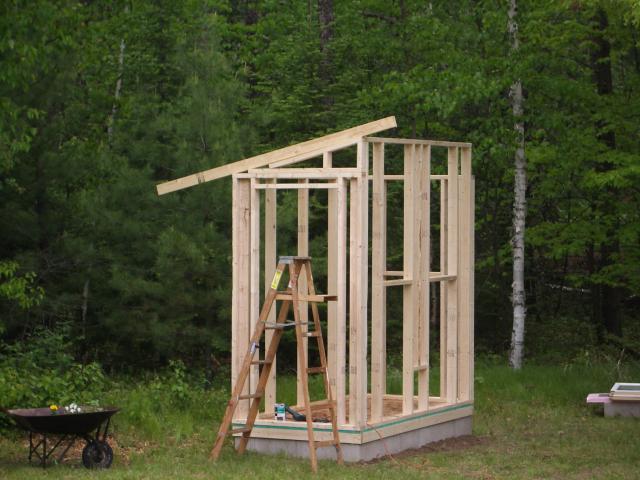
I covered the exterior walls with 3/8" LP SmartPanel. I covered the interior walls and ceiling with 3/8" LP Smartside soffit and insulated with closed cell foam insulation. The door to the run I built with 3/8" LP SmartPanel with 2" foam insulation sandwiched in between to prevent heat loss.
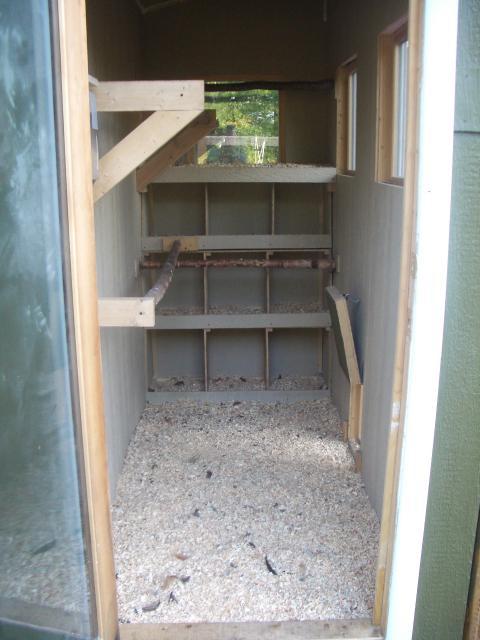
I built several roosts from birch, red oak, and aspen branches which I continually had to raise to their present locations as the chickens grew. The nests I built from 3/8" LP SmartPanel stacked on the Northeast wall. I had planned on building exterior doors to the nests for egg gathering but ended up deciding against it, something I may regret.
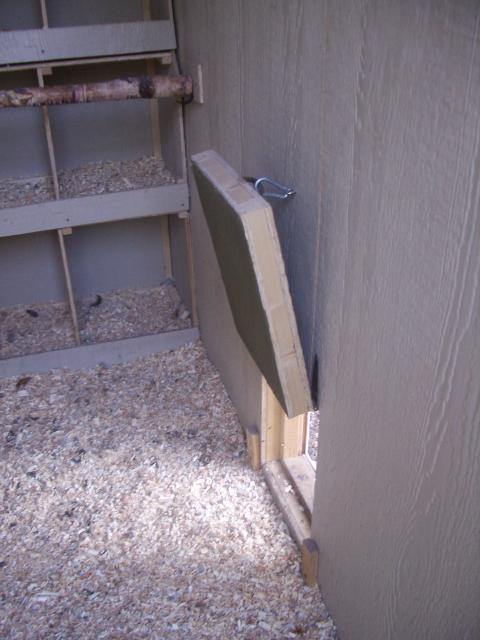
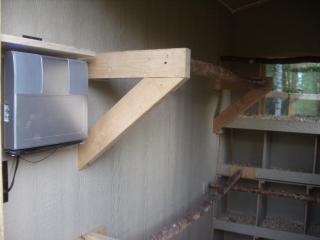
I wired the coop running 14/2 exterior wire from the house and wired in a ceiling light with interior coop switch and a switch in our basement (to add light for egg production during the short winter months) and a wall outlet for plugging in heater waterers, etc. Since I had the coop wired I decided to add a AM/FM CD player to let the chickens listen to the local radio station WJJQ.
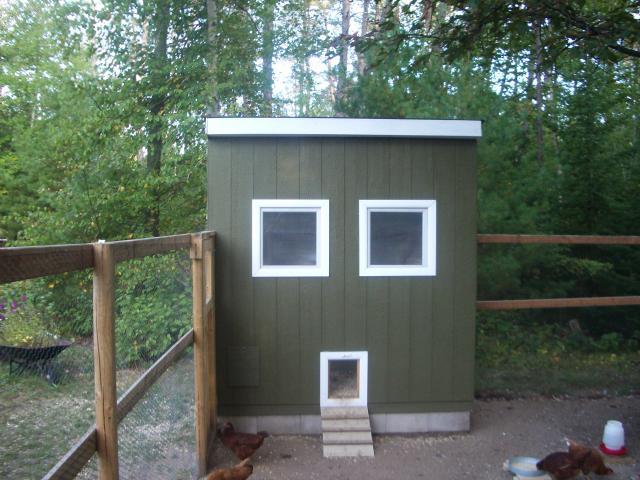
The run is 16' x 28'. I used landscape timbers for posts and chicken wire with 2 x 4s placed six feet high along the top of the posts and 1 x 4s placed at 36" high to secure the chicken wire. I left the top open because of the many comments I read regarding snow/freezing rain collapsing or sagging the wire. There is a red oak tree in the run to minimize the risk from eagles and hawks which would also create a problem for me to cover the run. So far we haven't had a problem. Before the snow flies I will be adding several more roosts in the run to allow the pullets to be out of the snow and I will raise the mini-coop in the run above snow level and keep it filled with fresh shavings.
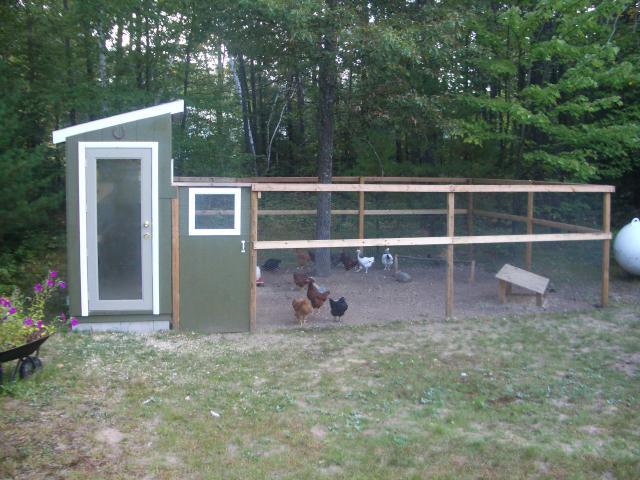
The coop and run have became a place where my wife and I sit in the evenings and watch the chickens. It is quite entertaining. My daughter has named all the chickens and many of her friends enjoy coming over and sitting with the chickens. Most of them will come up and sit in her lap and one of the Auracanas enjoys sitting on her shoulder.
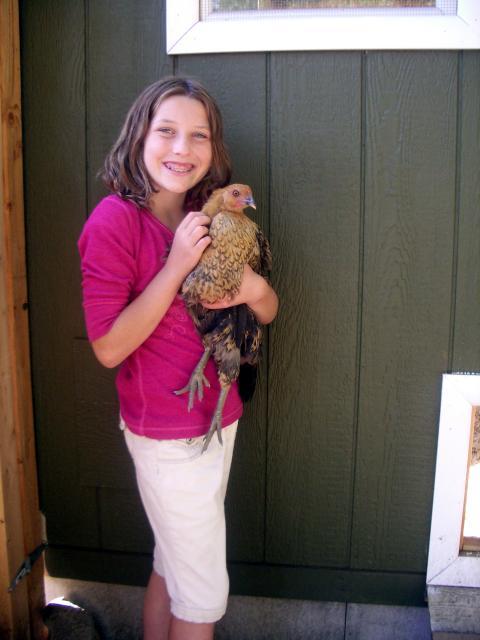
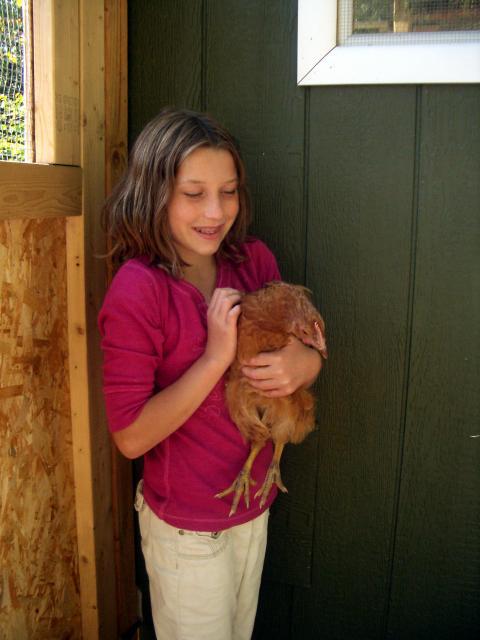
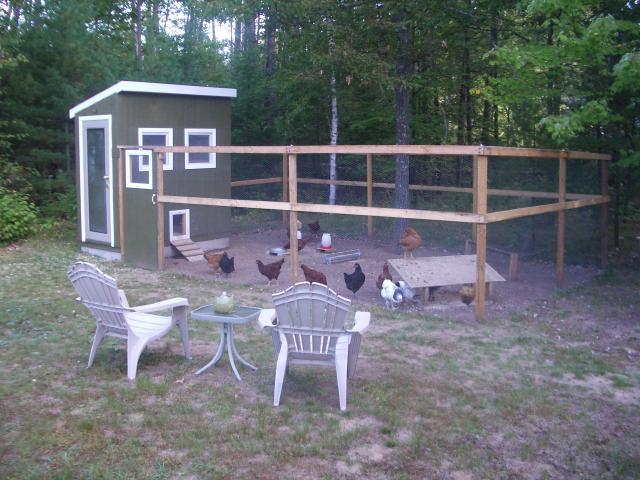
Currently all of the water and feed are kept in the run as we leave the door to the run open 24/7. We will end up bringing one of the waterers and feeders inside the coop during the winter months as we intend on closing up the coop on the coldest nights. We are still feeding the PenPals medicated starter feed since the pullets are still only 14 weeks old. At 18 weeks we are going to switch them to a laying feed mix designed by the Hometown Feedmill which we will supplement with oyster shells.

